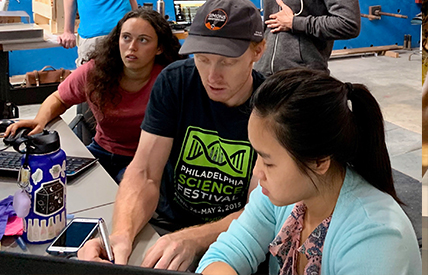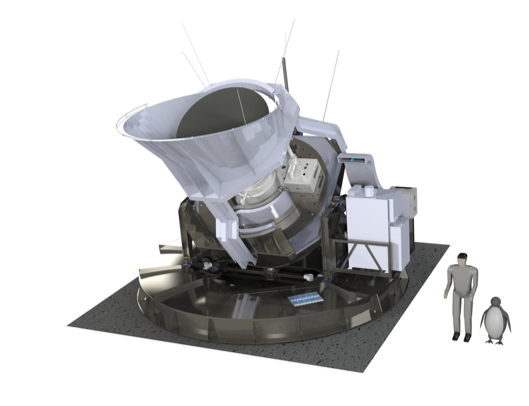UC San Diego Cosmologists Ramp-Up Exploration of the Universe’s Origin, Evolution
Distinguished Professor Brian Keating and his team begin integration and testing of an advanced cryogenic telescope receiver for the Simons Observatory cosmology experiment
January 23, 2020 | By Stuart Volkow
 Students, Tran Tsan (background left), UC San Diego, and Tamar Ervin (top right), UCLA, on the ACEC research team at High Bay Physics Laboratory, led by Postdoctoral Fellow Nicholas Galitzki (front left), prepare the cryostat while the crane helps stead it. Photo courtesy of the Stuart Volkow Photo Collection, High Bay Physics Lab and SAT1
Students, Tran Tsan (background left), UC San Diego, and Tamar Ervin (top right), UCLA, on the ACEC research team at High Bay Physics Laboratory, led by Postdoctoral Fellow Nicholas Galitzki (front left), prepare the cryostat while the crane helps stead it. Photo courtesy of the Stuart Volkow Photo Collection, High Bay Physics Lab and SAT1
UC San Diego’s Ax Center for Experimental Cosmology (ACEC) at the Center for Astrophysics and Space Sciences (CASS) opened a new lab space called the High Bay Physics Laboratory to integrate and test cryogenic receivers for the Simons Observatory’s small aperture telescopes, known as SATs. These, along with a large aperture telescope, will make up the observatory’s array of four instruments that will measure the oldest light in the universe with unprecedented precision. This detail will offer scientists a glimpse into the nature of fundamental physical processes that have governed the evolution of the universe since the dawn of time.
The High Bay lab features cutting-edge cryogenic equipment necessary to achieve the ultra-cold temperatures required by the Simons Observatory’s superconducting detectors. With 60,000 detectors—more than all the other Cosmic Microwave Background (CMB) experiments combined—the observatory, one of the highest in the world located at 17,000 feet (5,100 meters) in the Atacama region of Chile, is the most ambitious observational cosmology experiment ever undertaken. Its half-meter-wide SATs can scan a large patch of sky with the goal of measuring some of cosmology’s most elusive mysteries, such as primordial gravitational waves from the origin of the universe.
The advanced cryostat reached its first milestone in July using a powerful, helium pulse tube cryocooler to achieve a chilly 4 Kelvin (-452º F). During this initial testing, structural weaknesses were found in the thermally isolating tabs that bear the weight of precisely aligned optics inside the vacuum shell. But UC San Diego’s cosmology research team reworked the tabs last month and began the reassembly.
 Nicholas Galitzki (seated at center) runs the data with students at the High Bay Lab. Photo courtesy of the Stuart Volkow Photo Collection, High Bay Physics Lab and SAT1
Nicholas Galitzki (seated at center) runs the data with students at the High Bay Lab. Photo courtesy of the Stuart Volkow Photo Collection, High Bay Physics Lab and SAT1
Using the lab’s overhead crane, the nearly 4,000-pound (1800 kilogram) aluminum cryostat was hoisted onto its cart and rigged with shielding, heat-straps, insulation, thermometry and precision electronics for testing. The team also installed the dilution refrigerator, which, with a recycled mixture of helium-3 and helium-4, will allow the seven superconducting detector wafers at the telescope’s focal plane to reach their target operating temperatures of 0.1 Kelvin, or -459º Fahrenheit.
Postdoctoral researcher, cryogenic specialist and Simons Observatory collaborator Nicholas Galitzki (AKA Iceman, @AstroDrNick) has seen the project evolve from its design phase and supervised the opening of High Bay Lab.
“After over two years of intense design work, it is incredibly exciting to have the object we designed finally in the lab with all the cryogenic components working,” he said. “These are complex precision instruments, and we know there are bound to be unforeseen problems. Finding solutions is part of process and results in better science. I’m looking forward to leading the next stage of the project, which will see our fantastic team of graduate and undergraduate students bring all the telescope components together for the first time to create the first fully operational instrument for Simons Observatory.”
The cryostats for all three of the SATs are being custom built by Criotec Impianti SpA in Torino, Italy, and the specialized cryogenic dilution refrigerator component, unique to these instruments, is supplied by Finland’s BluFors. The detectors are being fabricated offsite, at UC Berkeley’s Marvell Nanofabrication Lab and at the National Institute of Standards and Technology (NIST) in Boulder Colorado.
 Rendering of the SAT telescope. Image courtesy of Nicholas Galitzki, UC San Diego
Rendering of the SAT telescope. Image courtesy of Nicholas Galitzki, UC San Diego
Other components are being contributed by collaborators around the world, including readout electronics, superconducting quantum interference devices (SQUID), lenses, filters and a half-wave plate that spins on a magnetically levitated superconducting bearing, first designed for the predecessor of the Simons Observatory, the Simons Array. UC San Diego will take delivery on two more SATs before sending them on for further integration and testing at Lawrence Berkeley National Laboratory, and at Professor Jeff McMahon’s Experimental Cosmology and Astrophysics Lab at the University of Chicago.
The three SATs will work alongside one six-meter-wide Large Aperture Telescope (LAT), under construction by Vertex Antennentechnik GmbH in Germany, with its receiver being built at the University of Pennsylvania. The LAT has fine angular resolution and can scan at arcminute scales—ideal for detecting gravitational lensing and galaxy clusters.
UC San Diego Staff Researcher Grant Teply has been part of the SAT design team since it began in 2017.
“I’m delighted the cryostat design has worked so well. We’re all looking forward to the integration and testing that will happen over the next year as we receive optical, detector and readout components from our collaborators,” he said. “I’m anticipating being onsite in Chile for commissioning the first of the three SATs sometime in 2020.”
UC San Diego Distinguished Professor of Physics Brian Keating is the director of the Simons Observatory, funded by the Simons Foundation, the Heising-Simons Foundation, and its partner institutions. The $75 million project collaboration has more than 260 members from over 40 institutions around the world. It is scheduled to begin its five-year study in 2022. In June 2019, Keating was joined by collaborators Professor David Spergel of Princeton and The Flatiron Institute, UC Berkeley Physics Professor Adrian Lee, and Dr. Jim Simons and Dr. Marilyn Simons for a groundbreaking ceremony at 17,000 feet above sea level at the site on Cerro Toco in Chile’s Atacama desert.
